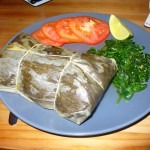Food for Thought – What Should Your Taste Buds Expect on the Delegation?
/It may not be the first thing you think of when you decide to go on a delegation, between seeing our projects firsthand, meeting the communities you support and traveling logistics, but food plays an important role to any visit to Nicaragua. And it’s not just about the ubiquitous rice and beans! Nicaragua has a raft of national dishes, and the best way to sample these on one of our trips is in the communities where we work. Our volunteer Marina is an excellent cook, and never misses a thing when preparing “la comida nica” for the uninitiated. Here are a few of the things you might expect…
Hearty and healthy, Gallo Pinto is Nicaragua’s traditional dish. It can be served as breakfast, lunch or dinner (and is often all three for Nicaraguans) on its own or with eggs, cheese or tortillas. Made from rice and red beans and cooked with onion, garlic, red pepper and salt, the recipe for Gallo Pinto (‘Painted Rooster’, from the maroon coloring of the beans) barely changes. A bit of cilantro or hot sauce will spice it up a bit if you find you are eating it every day of your trip.
Nacatamales
 These are usually served on special occasions, but they sometimes crop up for a nice Sunday “brunch”. Similar to Mexican tamales only a lot bigger, nacatamales consist of a corn mix (or “masa”), potatoes, pork, rice, beans and tomatoes, along with spices and seasoning, all wrapped in a large banana leaf. It’s no wonder they are only served in times of rest, and they are so tasty it’s impossible to leave any behind!
These are usually served on special occasions, but they sometimes crop up for a nice Sunday “brunch”. Similar to Mexican tamales only a lot bigger, nacatamales consist of a corn mix (or “masa”), potatoes, pork, rice, beans and tomatoes, along with spices and seasoning, all wrapped in a large banana leaf. It’s no wonder they are only served in times of rest, and they are so tasty it’s impossible to leave any behind!
Allegedly named after Pope Pius V because of its five ingredients (cake, custard, cinnamon, raisins and rum), this is a Nicaraguan dessert made to perfection by our volunteer Marina. The Flor de caña rum is hidden at the very bottom of the cup, meaning you have to dig past the cake with your spoon to reach it.
A hot beef, tomato, orange and achiote stew might not be the first thing you think of when it’s 90 degrees out, but if you’ve spent the day digging trenches for water pipes, building shelves for the libraries or walking dusty paths to visit rural communities, it might be just what you need. Legend has it that the name goes back to the days of Conquistadores in Nicaragua, who would take advantage of food offerings from the local population. Eventually, tired of having to share their food with their oppressors, the indigenous Nicarao waited until one Conquistador asked what was cooking. “It’s an old Indian (indio viejo) who had breathed his last breath”, he replied. That night, and from then on, the Nicaraos were able to enjoy their beef stew alone.




